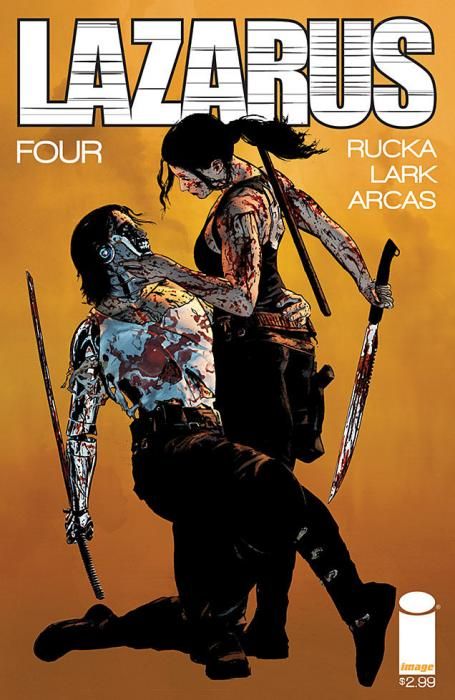Betrayal comes to a brutal head in the end of Greg Rucka and Michael Lark's stunning "Lazarus" debut arc from Image Comics. "Lazarus" #4 focuses primarily on the aftermath of the bomb, and it's the first chance to really see Forever cut loose physically to highlight her full capabilities.
Rucka does a fantastic bit in this issue as he cuts away from Forever's fight with her own family's soldiers back to the lab where those that "keep her running" monitor her state -- both her injuries and how she performs even when injured. It's a nice bit of world-building and commentary about these characters, seamlessly woven into the story. Intercut into the fight is the villain Forever should really be worried about, as her sister Johanna has herself beaten so that she can escape blame for the attack. It's clearly what Johanna was planning all along and while it's not the most original plot point ever written, Rucka and Lark handle it perfectly. Again, it's a great example of doing effortless character building and layering the plot all in one pitch perfect scene.
At the same time, there are very simple quiet moments between Forever and Joacquim that hint at what may come and serve as a stunning contrast to all the violence and betrayal. The two characters that get each other, and even though there's almost nothing romantic actually on the page, there's a subtle (but undeniable) unconventional Romeo and Juliet vibe between them. The end of the issue ends, not necessarily on a cliffhanger, but with a great tease that will have readers aching for the next installment.
Lark's art with an assist by Brian Level is visceral and brutal for all the right reasons. The art is most successful in how it contrasts the quiet scenes with the brutal violence, and it's a credit to Lark that he gives both moments the weight they deserve. Lark also does an excellent job with the technical moments as Forever's family "experiences the fight" via watching the damage and response to Forever's body. This could have easily been a stumbling block for the story but Lark gives it a life and urgency all its own. Santi Arcas's color palettes are well chosen, dancing from the purples of a desert sunset battle, to the artificially lit interior of the lab. There's also a fantastic sense of time as the sun sets slowly through the book -- house scenes that begin with an orange glow end up in the shaded blues of night.
"Lazarus" #4 is a pitch perfect ending to a stand out new series; it's the kind of book that reminds fans just what great comics are capable of. Emotional and resonant, beautiful and smart, "Lazarus" leaves readers begging for what happens next.

